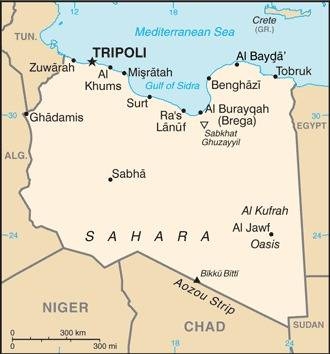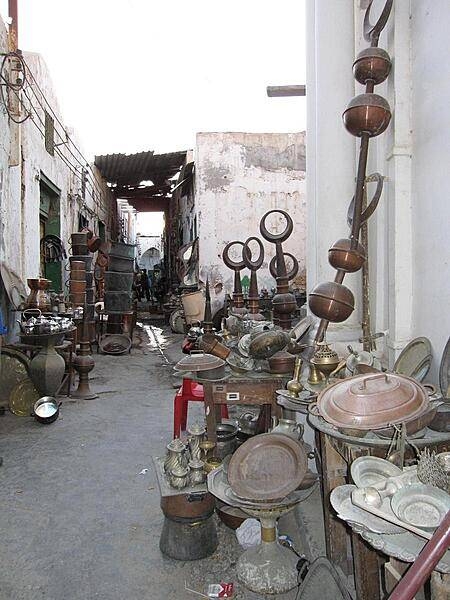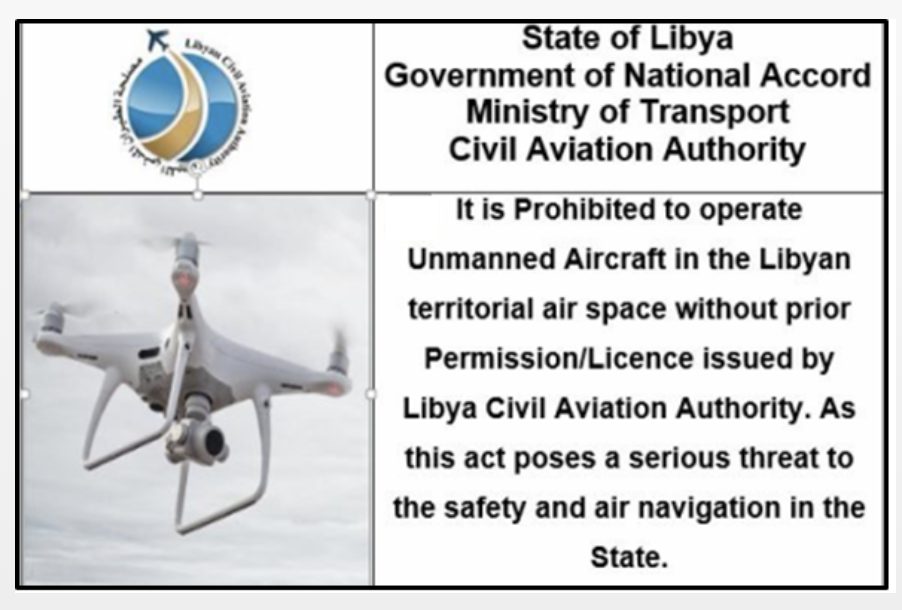205 Libya

Three horizontal bands of red (top), black (double width), and green with a white crescent and star centered on the black stripe. The National Transitional Council reintroduced this flag design of the former Kingdom of Libya (1951-1969) on 27 February 2011. It replaced the former all-green banner promulgated by the QADHAFI regime in 1977. The colors represent the three major regions of the country: red stands for Fezzan, black symbolizes Cyrenaica, and green denotes Tripolitania. The crescent and star represent Islam, the main religion of the country.
Flag courtesy of the CIA World Factbook

Map courtesy of the CIA World Factbook

Tripoli’s medina (old city quarter) includes craftsmen of several specialties, including the copper market. Copper forges line each side of the alley where craftsmen may be observed at work.
Photo courtesy of the CIA World Factbook
Government
According to Britannica, in September 1969 the monarchy of Idris I was overthrown and the constitution suspended in a military coup d’état. In 1977 the 12-member Revolutionary Command Council (RCC) formed after the coup was replaced by the General Secretariat of the General People’s Congress (GPC), with Col. Muammar al-Qaddafi as secretary-general. He resigned the post in 1979 but remained the de facto ruler of the country and head of the revolution until he was forced from power by an uprising in 2011.
Under the rule of Qaddafi, Libya was an authoritarian state, although it was theoretically governed by the masses through a series of councils. Qaddafi’s original revolutionary cabinet, the Council of Ministers, was replaced in 1977 by the General People’s Committee; each of the committee’s members served as the secretary of a department. The secretary of the General People’s Committee served as the head of government. In 1988 all but 2 of the 19 secretariats were moved from Tripoli, most of them to Sirte. The General People’s Congress served as a parliament.
Following the 2011 uprising, a transitional council made up of opposition figures assumed leadership. A multitude of militia groups, however, refused to disarm or be integrated into the national armed forces. Insecurity and factional rivalries soon became the main obstacles to the establishment of a stable permanent government.
The country is divided into shaʿbiyyāt (municipalities), which in turn are subdivided into smaller administrative units. Under Qaddafi, Libyan citizens were members of more than 500 “basic popular congresses,” each headed by an appointed revolutionary committee. Delegates came together in a General People’s Congress on the national level. There were no recognized political parties.
Under Qaddafi, the judicial system consisted of the Supreme Court, located in Tripoli, with five chambers of five justices each; it served as the final court of appeal. Regional courts of appeal, located in Tripoli, Benghazi, and Sabhā, each with three justices, heard appeals from the courts of first instance and from summary courts, the basic judicial unit, each with one justice per court. Separate religious courts were abolished in 1973, and all judicial courts based their rulings on Libyan law, derived from the Sharīʿah (Islamic law).
Civil / National Aviation Authority (CAA/NAA)
After the accession of the State Quebec ICAO in 1944, the administrative structure for Libyan civil aviation founded on 23rd Feb 1953 under the Libyan Aviation Administration, which represents legitimacy and legislative authority of the Libyan state in all forums and in front of bodies of local and international organizations in the field of civil aviation name.
Libyan Civil Aviation Authority (LCAA) is concerned with the implementation and application of the policies included in the Chicago Convention of 1944, signed by the Libyan state in 1953, becoming a member of the ICAO, the treaty provides the first article on the air that the absolute sovereignty of the state over the region in full.
Airspace
SkyVector – Google Maps – ADS-B Exchange
ICAO countries publish an Aeronautical Information Publication (AIP). This document is divided into three parts: General (GEN), En Route (ENR) and Aerodromes (AD). ENR 1.4 details the types of airspace classes they chose to adopt from classes A through G. Libya AIP
Drone Regulations

Advanced Air Mobility (AAM) Regulations & Policies
None found by the author.
However, should you, the reader, happen to stumble across something to the contrary, please email the author at FISHE5CA@erau.edu and you may be mentioned in the ACKNOWLEDGEMENTS section of this book by way of thanks for contributing to this free eBook!
Advanced Air Mobility (AAM) News
None found by the author.
However, should you, the reader, happen to stumble across something to the contrary, please email the author at FISHE5CA@erau.edu and you may be mentioned in the ACKNOWLEDGEMENTS section of this book by way of thanks for contributing to this free eBook!
Short Essay Questions
Question 1
You have been hired by a Drone Startup Company. Your boss has immediately assigned this job to you.
They need you to prepare a one-page memo detailing the legalities of using a drone to film the streets of Tripoli, pictured above.
They need you to mention any national laws and local ordinances.
They specifically want to know what airspace you will be operating in and whether or not you need an airspace authorization.
Does it matter whether or not you are a citizen of the country?
Lastly, there is a bonus for you if, as you scroll through this chapter, you find any typos or broken links!
Question 2
Do you need a certificate to fly UAS?
If so, how do you obtain one?
Are there fees associated with this?
If so, how much?
Question 3
May you operate beyond visual line of sight?
If so, what procedures must you follow?
Question 4
Does the country have UAM/AAM laws? If so, describe, citing the exact law.
Question 5
Are you aware of any new laws or policies not mentioned above? If so, describe, citing the exact law or policy.

